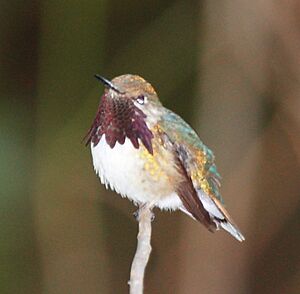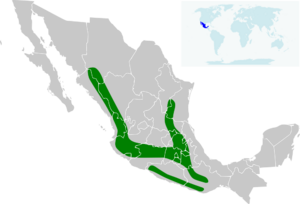Bumblebee hummingbird facts for kids
Quick facts for kids Bumblebee hummingbird |
|
|---|---|
 |
|
| Conservation status | |
| Scientific classification | |
| Genus: |
Selasphorus
|
| Species: |
heloisa
|
 |
|
| Synonyms | |
|
Atthis heloisa |
|
The bumblebee hummingbird (Selasphorus heloisa) is a tiny and beautiful bird. It is a type of hummingbird found mostly in Mexico. Sometimes, it can even be seen visiting the United States. This little bird is known for its small size, much like a bumblebee!
Contents
About the Bumblebee Hummingbird
The bumblebee hummingbird is one of the smallest hummingbirds in the world. It is about 5.9 to 7.5 centimeters (2.3 to 3 inches) long. This is roughly the length of your finger! It weighs only 2 to 2.7 grams (0.07 to 0.09 ounces). That's lighter than a penny! Both male and female bumblebee hummingbirds have a short, straight, black beak. They also have a small white spot right behind their eye.
Male and Female Birds
Male bumblebee hummingbirds are very colorful. Their upper body feathers are shiny, like metallic bronze or golden green. They have a special patch of feathers on their throat called a gorget. This gorget is a bright metallic magenta purple, sometimes with bluish edges. The feathers on their gorget can flare out. Their sides are a light reddish-brown color. The rest of their belly is a dull white or grayish-white.
The tail feathers of the male are also interesting. The middle ones are bronzy green. Other tail feathers are reddish-brown at the base and black on the outer half. They often have a bronzy green band in between. The tips of these outer feathers are wide and white.
Female bumblebee hummingbirds also have metallic bronze green upper parts. Their chin and throat are white with many shiny bronze spots. Their sides have more reddish-brown than the males. The rest of their belly is dull white or grayish-white. Their tail has less reddish-brown and more black than the male's. The tips of their outer tail feathers are off-white.
Different Types of Bumblebee Hummingbirds
There are two main types, or subspecies, of the bumblebee hummingbird. One is called S. h. heloisa, and the other is S. h. margarethae. The S. h. margarethae subspecies is a bit smaller than the S. h. heloisa.
Male S. h. margarethae birds have a dark purple gorget. Their belly is pure white, not grayish-white. Their sides are light buff, not reddish-brown. Female S. h. margarethae birds have smaller metallic spots on their throat. Their sides and under-tail feathers are light buff. Their tail feather tips are pure white.
Where They Live
Bumblebee hummingbirds live in the mountains of Mexico. The S. h. heloisa subspecies is found in central and southern Mexico. This includes areas from Tamaulipas to Guerrero and Oaxaca. The S. h. margarethae subspecies lives in northwestern and western Mexico. You can find them from Sinaloa and Chihuahua to Jalisco. There has been one sighting in Arizona, USA.
These birds like to live in mountain areas. They can be found inside forests, at the edges of forests, or in clearings. They prefer pine-oak forests, evergreen forests, and cloud forests. They also live in humid scrublands. They usually live at high elevations, between 1,500 and 3,000 meters (about 4,900 to 9,800 feet) above sea level.
How They Live
Moving Around
Most people think bumblebee hummingbirds stay in one place. However, some studies suggest they might move between pine-oak forests and cloud forests depending on the season.
What They Eat
Bumblebee hummingbirds mostly drink nectar from many different kinds of flowers. They can feed at any height in the plants. But they usually prefer flowers that are low to middle heights. When they drink nectar, they often hover in a horizontal position. Their tail is usually cocked up.
Even though they are small, they are often pushed away by bigger hummingbirds. But their tiny size sometimes lets them feed in areas where larger birds are. This way, they can get food without fighting. Besides nectar, they also eat small insects and spiders.
Making Nests and Raising Young
Male bumblebee hummingbirds perform a special dance to attract a female. They hover in front of her, spreading their colorful gorget. Their tail is also cocked up. They also move up and down rhythmically while still facing the female.
Bumblebee hummingbirds have been seen breeding between April and July, and sometimes in December. One study in Oaxaca found nests from late January to early March. The nest is shaped like a cup. It is made of moss and lichen. It might also have fibers from other plants. One nest was found on a thin branch of an avocado tree. It was about 10 meters (33 feet) above the ground. We don't know how long the eggs take to hatch. We also don't know how long it takes for the young birds to leave the nest.
Sounds They Make
The song of the bumblebee hummingbird is a high, thin, whining sound. It sounds like "sss ssssssssis" or "seeuuuuu." This song is long and fades at the end. They sing it from a perch. Their calls are high "chips," similar to other hummingbirds in their group. When the male flies, his wings make a buzzing sound like an insect. This buzz gets louder during his courtship display.
Conservation Status
The bumblebee hummingbird is doing well. The IUCN (International Union for Conservation of Nature) says it is a species of "least concern." This means it is not currently threatened with extinction. It lives in a large area. Even though we don't know the exact number of birds, their population seems stable. There are no immediate dangers to this species. The Mexican government also does not consider it to be threatened.


